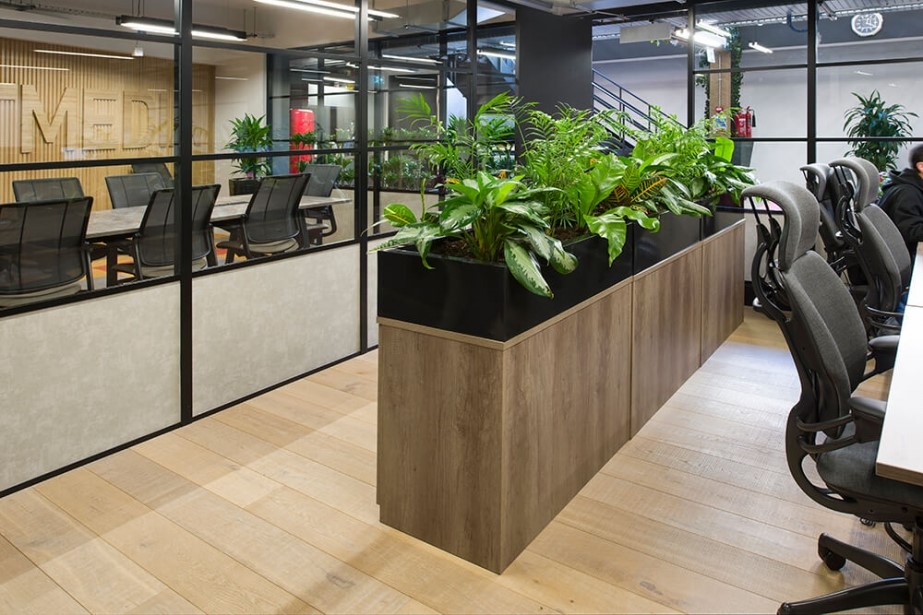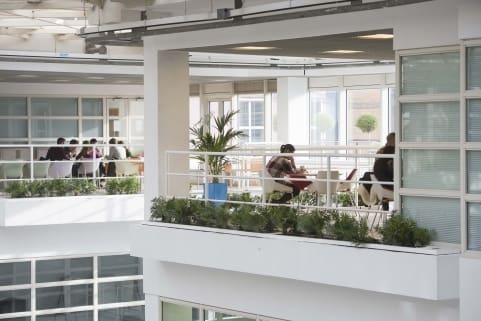We spend a great chunk of our lives at work. For some, this isn’t so bad. Walk into a high-ceilinged workspace, filled with natural light, artwork and plant life and it’s more than likely your creative ability will be invigorated. Yet these offices are few and far between, with the reality likely being a drab, open plan office that sucks the creativity and enthusiasm from you the longer you spend there. The way we design our offices is important, from the big aspects to the small, from the obvious to the obscure.
This informative report is the result of research conducted by Where We Work, written by Jessica Andrews with input from Planteria Group.
Where We Work offers a focused range of workplace consultancy services, with the necessary tools and expertise to help understand your business, your people, and your place of work. Where We Work partners with clients to develop a robust workplace strategy by looking, listening and discussing how each company interacts with their space.
Biophilia is word that you’re going to be hearing a lot more of and it’s going to have an ever increasing influence on interior design and architecture. Yet many of us are probably unfamiliar with this term. This paper seeks to explain the concept of biophilia and its application in an office environment as well as investigating the potential benefits of plants in the workspace and why they are so often a forgotten element.
What is Biophilia?
Let’s start with the basics. What is biophilia? Simply put, it literally means ‘a love of life or living things’; stemming from the Greek word ‘philia’, meaning love. As humans, we have an intuitive and deeply ingrained connection with nature and a biological need for immersion in the natural world. The relationship between people and plants has always been profoundly important. Biophilic design is a response to this human need, which works to re-establish contact with nature in the built environment. Plants affect every aspect of our lives; without them life as we know it would not be possible. Plants not only make the air breathable, but kick off the food chain. We feel good in nature, if you were asked to picture a place where you feel calm and relaxed, chances are you would pick a scene involving nature. This is backed up by statistics which show that 90% of us imagine a natural setting when presented with this task (Mocha, 2013). Our mental and physical well-being depends on engagement with the natural environment, being in a drab room without windows and piped air makes us feel lethargic, even depressed.
A connection with the natural world is clearly important. Yet we are living in ever more urban environments, deforesting trees to build our cities around the globe. The increasing academic and organisational interest in biophilia and biophilic design is driven by the positive outcomes that it can help to create, for both individuals and businesses.
This increasing interest in biophilia comes at a time when, as a species, we are more disconnected from nature than we have ever been. Living in an inner city, one can go days without seeing a patch of grass. Living and working in central London, you have to actively search out areas of green, else it could be weeks before you escape the underground, sky scrapers and office spaces overlooking (you guessed it), yet more concrete.
At a time when businesses have more knowledge than ever before on the effect of work environments on their people and their bottom line, it’s surprising that the biophilic agenda is still in its infancy.
In its rawest form, biophilic design is the theory, science and practice of bringing buildings to life and aims to continue a person’s connections with nature in man-made environments, such as offices, where we live and work every day. By mimicking natural environments in man-made ones, we can decrease our isolation from nature and create workspaces that are imbued with positive emotional experiences. (Human Spaces, 2015)
Bringing nature to work
Biophilic design brings an office to life. The benefits of biophilia stretch far beyond the practical benefits of recycling clean air.
Recent research into biophilia has found the positive impacts contact with nature can have. Studies have shown that this impact includes increasing academic performance amongst school children, increasing consumer’s willingness to spend and even reducing stress and anxiety before medical procedures. People exposed to natural surroundings are more energised, feel less stressed and have improved attention spans (Human Spaces, 2015) – all good news for employers. Recently, white papers such as ‘The Economics of Biophilia’ have shown us that natural materials in a workspace are not extravagances, but a way to make cost-savings and drive profits. (Terrapin, 2015)
Analysis has shown that individuals with a view from their desk of natural elements such as water, trees or countryside have greater levels of well-being that people who have a view of buildings, roads or construction sites (Human Spaces, 2015). However, one study found that just 58% of workers have natural light reaching their desk and 7% have no windows at all – a clear indication that the benefits of bringing nature to work are not appreciated or applied to the workplace nearly enough.
However, it is important to note that in some cases it is not possible to provide employees with views of nature. If offices are located in the centre of a large city, it would not be a practical aim to strive towards. In these cases, it is possible to bring nature inside. Introducing plants, trees, water fountains and images of nature are all ways to add a biophilic element to an office space, increase the connection employees have to nature and reap the benefits this sows.
This may sound like a daunting task, but bringing plants into the office space has never been easier. Help is also at hand in the form of companies with a wealth of knowledge into biophilia and its application in an office environment.
Planteria case study
So we know that plants make us feel good. But how does this feeling directly apply to the workplace? How does having plants in the office impact the bottom line and how can business maximise the potential benefits?
Planteria Group are a company specialising in planting services, with clients in many different sectors including corporate offices. Established in 1977, Planteria have grown over the past 40 years and now provide a national service to over 900 sites across the UK. They have seen an increasing appreciation of the importance of planting in the work place.
“We have seen a change in the attitude towards planting in the work place. What was once considered a ‘nice to have’ is now more likely to be viewed as a ‘must have’ and this is very positive. However, we still have a way to go in raising awareness of the importance of biophilia and the beneficial effects it has on people, improving wellbeing in the work place, especially with businesses outside of our major cities. Yes, planting helps to improve productivity and creativity but most importantly it improves physical and mental health and creates a happier environment. So much time is spent at work, creating the best possible environment for your people is paramount.
Plants and flowers do so much more than add the finishing touches to an interior they can create a completely different ‘feel’ to a location. What was clinical and bland can be transformed into a vibrant, or more relaxing space. Planting can also be used for practical benefits. For example, a living wall or moss wall will improve acoustics by absorbing sound. Cabinet top planting can cut clutter by removing the areas where people leave cups and folders or unclaimed printing. Or add live planting dividers to get the benefits and attractiveness of plants whilst creating instant, low cost break-out areas and informal meeting spaces in open plan office.
As one of the first tenants to make their home in London’s Iconic Walkie Talkie building. Insurance specialists, Lancashire Group were looking to buck the trend. Their focus in establishing a single office for their combined Lloyd’s and London market operations was to move away from the more usual monochrome minimalism and instead opt for a warm, homely, fun atmosphere for the workplace, with soft furnishings and materials to create a look that managed to be both high-end and cosy.
Plants were an essential element to complete the interior and we chose them with care to reflect and enhance this concept. We used bark containers in the client waiting area along with neutral white containers in the office and meetings rooms. Succulent plants add a fun, contemporary touch to the breakout areas, and funky square cabinet top displays completed the fit-out.”
Biophilia and productivity
An all too common belief is that money spent on plants is money wasted (Dravigne et al., 2008). This is a sentiment that has been widely shared throughout history, where literature argues that clean, obstruction free work spaces are the most economical route to business health and productivity (e.g. Haberkorn, 2005).
The ‘lean’, rather than ‘green’, philosophy has a long history indeed. The idea that productive workplaces are those free from interference was formally put across by Josiah Wedgewood in the 18th century and it was this work which inspired Frederick Taylor (1911) to apply the principles of scientific management to office space.
In the wake of these findings, it is common for managers to insist that workspaces should be clear of plants, pictures and anything that is not directly required for the job at hand, in order to streamline operations and maximise productivity (Haslam & Knight, 2006). Yet doesn’t basing these assumptions on work that is over a century old seem a little foolish? Indeed, the workspace, the products and services we provide and the technology we use would be unimaginable to Taylor when he came up with his theories.
The evidence suggests that to neglect enrichment in the workplace is foolish indeed. Research by Knight and Haslam in 2010 found that people who work in an environment enriched with plants were more productive than their peers who worked in a lean space. Additionally, levels of wellbeing – measured by sick days, feelings of comfort and levels of job satisfaction – were significantly higher in the spaces containing plants. This study found the lean space to be inferior in all dimensions.
Why do plants have this impact?
Generally, studies into the impact of plants have indicated that we experience a beneficial psychological and physiological reaction from being exposed to nature. Physiological stress, or arousal (as measured by heart rate, blood pressure, and/or skin conductance) is often lower after exposure to plants and nature as compared with urban settings and exposure to nature has been shown to have the capacity to improve attention (Berman et al., 2008).
As it stands, there are three main classes of explanation for these responses. The first states that plants, as living organisms, have a beneficial influence on the climate of the working environment – in particular because they improve air quality. Indeed, when planted in sufficient quantity, indoor plants have been shown to remove many types of air-borne pollutants from both indoor and outdoor sources (Nieuwenhuis et al., 2014). In offices with plants, staff well-being increases and there is a reduction in sick leave (Bergs, 2002). Plants ability to absorb carbon dioxide also has beneficial implications for the office; studies have found that student performance declines with increasing CO2 levels (Shaughnessy et al., 2006), as does workplace productivity (Seppänen et al., 2006).
The second explanation of plants’ beneficial effects revolves around our evolution. Evolutionarily speaking, a green environment reflects the natural world and so supports human physiology (Appleton, 1975).
The third and final class of explanation moves away from physiological responses and instead considers the managerial consequences of enrichment. The basic premise of this theory is that enrichment of the workplace (whether through plants or other means) signals that attempts are being made by management to improve staff well-being (Vischer, 2005). This sense of managerial care communicates their focus on employee well-being, which may lead to increased attention at work, greater productivity and engagement and lower absence and attrition. Evidence supporting this idea comes in the form of a study by Dravigne et al. (2008), which showed that people working in offices with plants reported feeling happier in their job and their performance.
Additionally, this study emphasises the aforementioned point that transforming a lean office to a green one contributes not just to employee welfare, but also to profits and organisational output. Lean, it appears, is meaner than green, not only because it is less pleasant, but also because it is less productive (Nieuwenhuis et al., 2014).
When we’re happy and feeling good, we have a more positive outlook and are generally able to do more. There is clear evidence which directly links biophilia with organisational output. In a study of call centre workers, the numbers of calls handles per hour was 6-7% greater for those with a view of the outdoor environment, in comparison to those with no view. (Human Spaces, 2015)
It is clear that enriched spaces lead to improved job performance and greater productivity. Yet of course, this idea that empowering organisational strategies have positive consequences is not new to either social or organisational psychology. Both of these disciplines benefit from massive literature supporting the notion that productivity and well-being can be enhanced by including employees in the decision making process and giving them a voice in their workplace (e.g. Eggins et al., 2002).
So, with this abundance of evidence pointing to the fact that enriched spaces make us happier and more productive, why are aspects such as plants not a feature in all modern office spaces?
The problem with the modern office
The way we structure our offices has changed considerably over the past few decades. More often than not, the world of the modern office is dominated by open plan. It’s not hard to identify why this change has occurred, the cost of space has sky rocketed and open plan provides a cost effective way to maximise the number of staff on the office floor. Yet the evidence suggests that the costs of open plan offices might offset the benefits of savings in terms of space if it is not implemented properly, as part of a multi-layered office design. They are often cramped, noisy and starved of light and some staff find themselves in the position of having no opportunity to express their identity at work – at all.
Studies across the pond have found that 70% of American workers personalise their workspaces. Yet it is managers and employees with enclosed offices who decorate more than their co-workers in open plan spaces (Wells & Thelen, 2002). In open plan spaces, personalisation of low-status working space is often infrequent and discouraged (Laing et al., 1998). The dominance of open plan offices means that the majority of staff now suffer from a lack of identity at work and a 2010 study by Knight & Haslam found that clean-desk policies resulted in high levels of personal identity threat, increased stress and a reduced willingness to contribute to company policy. This is thought to be due to the limited opportunities these staff had to express their personal identities, for example by decorating their workspace. Open plan offices themselves are not the problem, as they do have their benefits. However, it is important that offices be designed with the drawbacks open plan can have in mind and counteract these issues – for example by including quiet spaces, artwork and greenery.
A final thought…
The evidence that enriched spaces which involve employees in their design boosts morale and productivity is important. Perhaps most notably because it challenges the managerial models which argue the best way to manage is by removing autonomy and control from staff and having decisions come only from managers – as was noted by Bibby in 1996 (work which is still very relevant to academic research today). The fact that giving workers ‘some say’ in the design of their workspace is seen as ‘experimental’ indicates just how ingrained the ethos of managerial control has become.
At its core, the simplistic answer as to why plants are so often neglected lies with the individuals responsible for office design. The management of the modern office is typically influenced by architects, interior designers and facility managers, rather than by psychologists and office workers (Cohen, 2007). Managers need to move away from an autocratic style of management, towards a more collective approach to office design which involves staff at all stages of the process. Giving employees a say in the type of plants to introduce into a space is a great way to begin this movement.
The idea of incorporating nature into the built environment through biophilic design is less often seen as a luxury in the modern workplace, but rather as a sound economic investment into employees’ health, well-being and performance. Plants in the workspace can have a remarkable impact on employee well-being, both from the biological impact of their presence and the psychological benefit being involved in decision making can have. With this in mind, it seems that taking baby steps to introduce the natural world into the man-made one we have created around us, seems to be of the utmost importance to the well-being of office staff. It seems starkly apparent that green really is better than lean in all walks of life – and the modern office should be no exception.
Author: Jessica Andrews
References
Berman, M.G., Jonides, J., & Kaplan, S. (2008). The cognitive benefits of interacting with nature. Psychological Science, 19, 1207–1212.
Bibby, A. (1996). ‘Leeds: working life in Call Centre City’, updated from an original article in Flexible Working, August; http://www.andrewbibby.com/telework/leeds.html (last ac- cessed 27 June 2006).
Cohen, L. M. (2007). Bridging two streams of office design research: A comparison of design/behavior and management journal articles from 1980–2001. Journal of Architectural and Planning Research, 24, 289– 307.
Dravigne, A., Waliczek, T. M., Lineberger, R. D., & Zajicek, J. M. (2008). The effects of live plants and window views of green spaces on em-ployee perceptions of job satisfaction. HortScience, 43, 183–187.
Eggins, R. A., S. A. Haslam and K. J. Reynolds (2002). ‘Social identity and negotiation: subgroup representation and super- ordinate consensus’, Personality and Social Psychology Bulletin, 28, pp. 887–899.?
Haberkorn, G. (2005). Improving flow in an office setting. In Productivity Press Development Team (Ed.), The lean office: Collected practices and cases (pp. 95–104). New York, NY: Productivity Press.
Haslam, S. A., & Knight, C. P. (2006). Your place or mine? BBC News Web site. Retrieved from http://news.bbc.co.uk/1/hi/magazine/6155438.stm
Human Spaces. 2015. The Global Impact of Biophilic Design in the Workplace. Available from: http://humanspaces.com/global-report/
Knight, C. & Haslam, S. Journal of Experimental Psychology: Applied American Psychological Association 2010, Vol. 16, No. 2, 158–172 1076-898X/10/$12.00 DOI: 10.1037/a0019292
Laing, A., Duffy, F., Jaunzens, D., & Willis, S. (1998). New environments for working. London, England: Construct Research Communications.
Mocha. 2013. What is Biophilia? And why you need biophilic design in your home. Available from: http://www.mochacasa.com/blog/biophilia-biophilic-design/
Nieuwenhuis, M., Knight, C., Postmes, T., & Haslam, S. A. (2014, July 28). The Relative Benefits of Green Versus Lean Office Space: Three Field Experiments. Journal of Experimental Psychology: Applied. Advance online publication.
Terrapin. 2015. The Economics of Biophilia. Available from: https://www.terrapinbrightgreen.com/report/economics-of-biophilia/
Wells, M., & Thelen, L. (2002). What does your workspace say about you. Environment and Behavior, 34, 300–321.?








